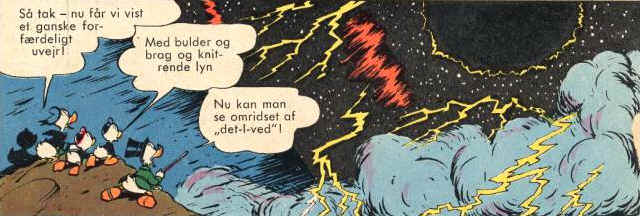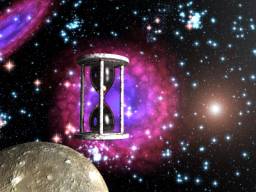
Sydnordisk Akademi for Donaldisme - Afdelingen for Donaldistisk Temporalforskning
The
Unthinkable Explanation for the Temporal Observations from “Stella anatium”
Has
Duckburg fallen into a Black Hole?
Af professor John T. Airhead, Department of Donaldistic Research
(DDR), University of Calisota -
med indledende forord af dr. J. GrandjeAnd (CKD)

Jeg har en sjælden indrømmelse: Jeg ER ikke den store
astrofysiker! Selvom jeg fulgte den matematisk-fysiske linie i gymnasiet, endda
med astronomi som specialefelt, og siden har muntret mig med fysisk
videnskabsteori på universitetet, er det ved at være længe siden, jeg for
alvor har arbejdet med astrofysiske problemstillinger. Derfor var det en kærkommen
lejlighed til atter at betræde mælkevejene i det højere luftlag, da
Donaldistisk Forum i efteråret 2003 bad mig redegøre for en mulig
klassisk-donaldistisk forklaring på tidsforholdene i Andeby. Resultatet kan læses
andetsteds i form af min temporal-relativistiske dobbelt-ellipsebane-teori.
Ved fremlæggelsen af min teori gik det op for mig, at jeg havde
visse vanskeligheder ved at gøre teorien forståelig for mine kollegaer. Med
tanke på disses generelle erkendelsesniveau foruroligede det mig nu ikke
videre, men værre var det, at jeg næppe heller kunne vente nogen videre faglig
kvalificeret kritik af teorien fra den hjemlige kant. Og hvad nu, hvis det utænkelige
skulle være sket; at jeg havde overset nogle afgørende forhold eller ligefrem
begået fejl? Derfor kontaktede jeg en god ven og kollega i udlandet med såvel
interesse for astrofysik som donaldisme, en person, der i donaldistiske
forskerkredse optræder som professor John Thomas Airhead. John har været så
venlig at kigge modellen og teorien kritisk igennem, og når jeg har foreslået
Fysik- og Geografiinstituttet på SAD, at offentliggøre hans (til lejligheden
lettere omskrevne) svar, hænger det sammen med, at hans kommentarer er ledsaget
af en for mig at se uhyre interessant - og gruopvækkende - alternativ
forklaringsteori: The Black Hole Thesis!
Dr.
J. GrandjeAnd

First of all, I would like to congratulate my Danish colleagues on their fine contributions to the Donaldistic research in general, and the study of the temporal conditions of Duckburg in particular. I have read the presentation of the papers from the temporal seminar with great interest. Without wanting to back any of the presented theses up at the expense of the others (at this time, at least), I will - because I have been asked to do so - concentrate on one thesis in particular; the so-called Temporal Relativistic Double Elliptical Orbit Thesis by dr. J. GrandjeAnd (the name of the thesis alone is worth some attention).
Dr. GrandjeAnd states that the temporal development in the empirical observations described are best explained with a parabola course of Stella anatium first towards and then away from planet Earth. I agree that this is a possible thesis, even though his explaining model figure has some minor faults. I understand, that the sketch is highly simplified, and that the marked positions of Stella anatium and Earth are not in fact meant to describe the relative positions of the actual planets, but their entire solar systems, galaxies or (parallel?) universes. The GrandjeAnd Thesis is, however, most valid if it was in fact the planets themselves, that moved as described, but this is of course not possible, unless dr. GrandjeAnd suggests, that Stella anatium is flying in its own elliptical orbit in our solar system completely independent of the Sun and the other planets. When we move to solar system or galaxy level, I must confess, I find the claimed switch from positive to negative Doppler Effect in the donaldistic signals over a time span of just five to ten years rather unlikely. But still, I shall not claim, that this is not possible, as we for instance still know very little on the relative behavior of parallel universes.
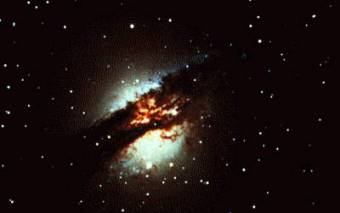
When all this is said, I will point out, that astro-physical science in
fact do know of a more likely explaining scenario for the temporal observations
of Stella anatium described by dr. GrandjeAnd. It is, unfortunately, what we
could call a “Worst Case Scenario”. As it happens, the observed temporal
development in Duckburg fits only to perfectly into the Black Hole Model!
Let us imagine that we are situated in a stationary spacecraft or base in outer space in safe distance of a Black Hole, and a brave volunteer - or an unlucky bastard, who fell a sleep during his guard - is sent off towards the Hole in a small spacecraft. Inside his ship, there is a camera, which continuously transmits pictures of our hero. Now, the Black Hole is fortunately several light years away from our mother ship, so it is a journey of a considerable period for the pilot. The pictures from the camera, which we receive on the mother ship, will show, how the pilot is ageing, as the years go by, but apparently, the ageing process will seem to slow down, as he is getting nearer the Black Hole. Why is that?

There are two reasons. Firstly, as described by GrandjeAnd, the signals will have still longer to travel, and therefore, the signals from year X+1 will arrive a little more than a year after we received the signals from year X. Depending on the speed of the signals and the distance they have to cover, the effect would, however, not be significant. The most important factor in the transmitting scenario of the example is the Black Hole, or rather, the enormous gravity of the Hole. The signals themselves will eventually be influenced by the gravity field of the Black Hole, and hence, the gravity field will have a negative effect on the speed of the signals sent from the small spaceship to the mother ship.
At some point, the pilot passes the horizontal line of the Black Hole, “the point of no return”, after which no more signals can escape the gravity. The crew on the mother ship will, however, never see this. They will continue to receive still more delayed signals from before the passage of the Black Hole Horizon. In the end, it will occur, as if time has come to a complete stop for the pilot. The signals from the last day will perhaps arrive to the mother ship over a period of a month or a year. Eventually, the signals will become weaker, and, finally, fade away. The pilot himself will not know when he has passed the Black Hole Horizon, and he will have no problem in sending out signals (they will just never reach the mother ship) or receiving signals from the mother ship (unless atmospheric noise will interfere his reception). What will happen to him inside the Black Hole, of course, nobody can actually predict, but most likely, he will in the end implode together with his ship to a microscopic lump of atoms - or perhaps rather a microscopic set of super strings. The point is, that the last pictures received on the mother ship will not be of a panicking or imploding pilot, as he at the time of the passing of the horizon will have no idea, of what is expecting him.
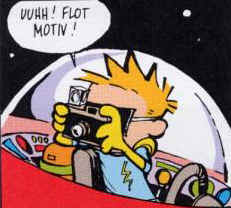
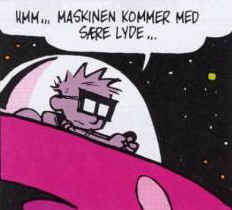

Ifølge professor Airhead vil tyngdekraften i det sorte hul have en forsinkende effekt på billedsignalerne sendt fra det lille rumskib til moderskibet, så man på sidstnævnte stadig kun vil se forsinkede billeder af den endnu ubekymrede pilot fra før passagen af hullets såkaldte horisontlinie (billedet til venstre), selvom piloten i virkeligheden på dette tidspunkt forlængst har passeret linien. Billeder af pilotens oplevelser inde i hullet (som i midten), herunder hans sidste desperate øjeblikke (billedet til højre), vil aldrig kunne nå moderskibet. Spørg derfor ikke, hvordan redaktionen har fået fat i ovenstående billedeksempler...
If you follow the “Classic-Donaldistic” point of view of dr. GrandjeAnd, or the view of most Barksists, is this then in fact not the actual scenario, we have witnessed in the transmissions from Duckburg? First, in the 1930s, the Ducks appear to age normally (whatever that is for a Donaldistic duck?), but as time goes by, the ageing process seems to slow down and come to a standstill from some point in the 1940s. After that, there appears to be no temporal development until the late 1960s, where the signals fade away with the stopping of Carl Barks (was this in fact the reason, why he stopped; there was no more signals to pick up?). Could this indicate, that we here on Earth unknowingly have stood by as the crew on the mother ship and witnessed the last voyage of Donald Duck into the Twilight of the Gods? Has the entire Stella anatium met with its ultimate destruction? Oh, what a horrible thought! How unthinkable, how unbearable. But as scientific scholars, we cannot afford to rule out even the most horrific possibilities, if they are in fact plausible. As professor Dam has pointed out, the GrandjeAnd Thesis does not explain the continued technical development from 1940 to 1970. Exactly the same can be stated against this Black Hole Thesis. It has only been my aim to point out, that given the conditions, set by Dr. GrandjeAnd, the Black Hole Thesis must be considered as an alternative to his Temporal Relativistic Double Elliptical Orbit Thesis; and - in spite of the magnificent name of the latter - in my opinion, a more logical and likely one. But certainly not a more likable one...
